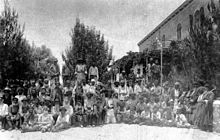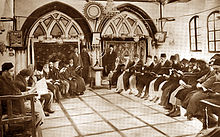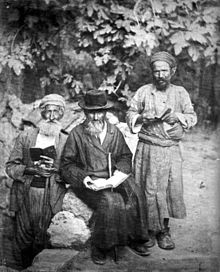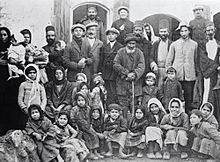Palestinian Jews
יְהוּדִים פָלַסְטִינִים اليهود الفلسطينيين | |
|---|---|
 Painting of Palestinian rabbi Raphael Hayyim Isaac Carregal by American artist Samuel King, 1782 | |
| Regions with significant populations | |
| Palestine (Land of Israel) | |
| Languages | |
| Religion | |
| Judaism | |
| Related ethnic groups | |
| Samaritans and Israeli Jews |
| Part of a series on |
| Jews and Judaism |
|---|
Palestinian Jews or Jewish Palestinians (Hebrew: יְהוּדִים פָלַסְטִינִים; Arabic: اليهود الفلسطينيين) were the Jews who inhabited Palestine (alternatively the Land of Israel) prior to the Declaration of the Establishment of the State of Israel on 14 May 1948.
Beginning in the 19th century,[1] the collective Jewish communities of Ottoman Syria and then of Mandatory Palestine were commonly referred to as the Yishuv (ישוב, lit. 'settlement'). A distinction is drawn between the New Yishuv and the Old Yishuv: the New Yishuv was largely composed of and descended from Jews who had immigrated to the Levant during the First Aliyah (1881–1903); while the Old Yishuv comprised the Palestinian Jewish community that had already existed in the region before the consolidation of Zionism and the First Aliyah.
In addition to applying to Jews who lived in Palestine during the British Mandate, the term "Palestinian Jew" has been applied to the Jewish residents of Southern Syria under the Ottoman Empire. There are also historical scholarly instances in which the Jewish populations of Palaestina Prima and Palaestina Secunda in the Byzantine Empire are referred to as Palestinian Jews.[2]
Following the dissolution of the British Mandate in 1948, the entire Palestinian Jewish populace was absorbed by Israeli citizenship law. Since then, the term "Palestinian Jew" has largely fallen into disuse, though some Israeli Jews may refer to themselves as Palestinians in historical or political contexts.
History
Ottoman era
Prior to dismemberment of the Ottoman Empire, the population of the area comprising modern Israel, the West Bank, and Gaza Strip was not exclusively Muslim. Under the empire's rule in the mid-16th century, there were no more than 10,000 Jews in Palestine,[3] making up around 5% of the population. By the mid-19th century, Turkish sources recorded that 80% of the population of 600,000 was identified as Muslim, 10% as Christian Arab and 5–7% as Jewish.[4]
The situation of the Jewish community in Palestine was more complicated than in neighbouring Arab countries.[5] Whereas in Yemen, Iraq, Syria and Lebanon, communities were largely homogeneous in ethnic and confessional terms, in Palestine in the 19th century, Jewish pilgrims and European Christian colonial projects attracted large numbers of Ashkenazi immigrants from Eastern Europe and Sephardic groups from Bulgaria, Turkey and North Africa.[5] The Jews of Palestine were not exclusively of Iberian origins, and included substantial Yiddish speaking communities who had established themselves in Palestine centuries earlier.[5]




Towards the end of the Ottoman era in Palestine, native Jewish communities lived primarily in the four 'holy cities' of Safed, Tiberias, Hebron and Jerusalem.[5] The Jewish population consisted of Ashkenazim (Yiddish speakers), Sephardim (Judeo-Spanish speakers), and Maghrebim (North African Arabic speakers) or Mizrahim (Middle Eastern Jews, comparable to the Arabic term Mashriqiyyun, or 'Easterners'). The majority of Jews in the four holy cities, with the exception of Jerusalem, were Arabic and Judaeo-Spanish speakers.[5] The dominant language among Jews in Jerusalem was Yiddish, due to the large migration of pious Ashkenazi Jews from Russia and Eastern Europe. Still, in 1882, there were registered 7,620 Sephardim/Mizrahim/Maghrebim, in Jerusalem, of whom 1,290 were Maghrebim, from the Maghreb or North Africa. Natives of the city, they were Turkish subjects, and fluent in Arabic.[5] Arabic also served as the lingua franca between the Sephardim/Mizrahim/Maghrebim and Ashkenazim and their non-Jewish Arab counterparts in mixed cities like Safed and Hebron.[5] However, during the Greek and Roman period, the primary language of Palestinian Jews was Aramaic, a Semitic language closely related to Hebrew.[6]
In the narrative works of Arabs in Palestine in the late Ottoman period, as evidenced in the autobiographies and diaries of Khalil al-Sakakini and Wasif Jawhariyyeh, "native" Jews were often referred to and described as abnaa al-balad (sons of the country), 'compatriots', or Yahud awlad Arab (Jews, sons of Arabs).[5] When the First Palestinian Congress of February 1919 issued its anti-Zionist manifesto rejecting Zionist immigration, it extended a welcome to those Jews "among us who have been Arabicized, who have been living in our province since before the war; they are as we are, and their loyalties are our own."[5]
British Mandate era
Despite the overtures by Palestinian Arabs by 1914 the local Arab population, which was uniting under a new concept of Palestinianism was becoming increasingly detached from the Arabic-speaking Jews over Zionism. Even though many Jews who spoke Arabic, identified as "Arab" and maintained intellectual networks in Cairo, Beirut, and Istanbul many of them were also supporters of Zionism and the Jewish colonization of Palestine. Jewish newspapers such as the HaHerut which dealt with Sephardic issues were Pro-Zionist and Pro-Ottoman and in many ways, similar to HaTzvi which was published by newly arrived Ashkenazi Jews. Attempts to ease the tensions were made by Arab-speaking Jews establishing societies such as HaMagen to counter Anti-Zionism in the Arab press, translate Arabic articles so newly settled Jews could understand Arabs and suppress anti-semitic publications but this was becoming challenging due to the rising wave of nationalist publications. [7]
In 1920 the Arab newspaper al-Quds al-Sharif called Palestinian Jews to live alongside Arabs and reject Zionism and recent arrivals, appealing to the long history of Sepherdic Jews had with Arabs. In 1921, the Palestinian delegation in London claimed to the British negotiation team that the local Sephardim opposed Zionism and the Palestinian press began reaching out to Sephardim calling but this time the pleas were met with stiff opposition from the local Palestinian Sephardic leadership. [7] The 1929 Anti-Jewish riots resulted in the final breakdown of relations between Palestinian Jews and Arabs with even Jewish communities that were opposed to Zionism joining together for protection creating a unified Yishuv. [8]
Name of Israel in Arabic
Official documents released in April 2013 by the State Archive of Israel show that days before the establishment of the State of Israel in May 1948, Jewish officials were still debating about what the new country would be called in Arabic: Palestine (Filastin), Zion (Sahyoun) or Israel (Isra’il). Two assumptions were made: "That an Arab state was about to be established alongside the Jewish one in keeping with the UN's partition resolution the year before, and that the Jewish state would include a large Arab minority whose feelings needed to be taken into account". In the end, the officials rejected the name Palestine because they thought that would be the name of the new Arab state and could cause confusion so they opted for the most straightforward option: Israel.[9]
Controversies and disputes
References to Jews in Europe as Palestinians
European Jews were commonly considered an "Oriental" people in many of their host countries, usually as reference to their ancestral origins in the Middle East. A prominent example of this was the 18th-century Prussian philosopher Immanuel Kant, who referred to European Jews as "Palestinians living among us."[10] [11]
Israeli Jewish usage
Yaakov Meir (born in 1856 in Jerusalem), the first Sephardic Chief Rabbi appointed in Mandatory Palestine, preferred not to use the term Palestinian Jew due to his Zionist affiliations. He spoke fluent Hebrew and encouraged the construction of new Jewish quarters of Jerusalem as well as the re-establishment of an Independent Israeli Jewish State. [12]
Ben-Zion Meir Hai Uziel (born in 1880 in Jerusalem) was the Sephardi chief rabbi of Mandatory Palestine from 1939 to 1948, and of Israel from 1948 to 1954. He served as a Mizrachi delegate to the Zionist Congress from 1925–46. As a religious Zionist, he strongly believed in the redemption of Israel and bringing the Jewish exiles back to the land to create a religious Jewish state of Israel. As a strong supporter of Israeli nationalism, in his writing The Redemption of Israel he wrote: "We all desire that the in gathering of the exiles should take place from all areas where they have been scattered; and that our holy language will be upon our lips and upon the lips of our children, in building the Land and its flowering through the hands and work of Israel; and we will all strive to see the flag of freedom and redemption waving in glory and strength upon the walls of Jerusalem."[13]
Mordechai Eliyahu (born in 1929 in Jerusalem) was a prominent rabbi, posek and spiritual leader. He served as the Sephardi Chief Rabbi of Israel from 1983 to 1993. Because Eliyahu was one of the spiritual leaders of the Religious Zionist movement he refused to use the term Palestinian and believed all Jews should refrain from using the term. He was an outspoken opponent of the Gaza Disengagement of 2005 and supported Jewish settlements in Gaza and the West Bank. He was considered somewhat controversial for his decades-long support of the radical right of the Religious Zionist movement. Eliyahu was a friend of Rabbi Meir Kahane and his family.[14]
Uri Davis, an Israeli citizen, academic, activist and observer-member in the Palestinian National Council living in the Arab town of Sakhnin, identified himself as an "anti-Zionist Palestinian Hebrew". Davis explained, "I don’t describe myself as a Palestinian Hebrew, but I actually happen to be a Palestinian Hebrew, I was born in Jerusalem in 1943 in a country called Palestine and the title of my birth certificate is 'Government of Palestine'. That is neither here nor there, though. It is significant only in a political context in which I am situated, and the political context that is relevant to my work, my advocacy of a critique of Zionism. I'm an anti-Zionist."[15] He has since converted to Islam in 2008 to marry a Palestinian Muslim woman, Miyassar Abu Ali, whom he met in 2006.[16] Since then he no longer considers himself Jewish.
Tali Fahima, an Israeli pro-Palestinian activist, describes her nationality as Palestinian. Fahima was born in Kiryat Gat, a development town in the south of Israel, to a family of Algerian Jewish origin. Fahima lives in the Arab village Ar'ara in northern Israel, and works as a Hebrew teacher. In June 2010, it was reported that she converted to Islam at a mosque in Umm al-Fahm.
Actor, director and activist Juliano Mer-Khamis, the son of an Israeli Jewish mother and a Palestinian father, described himself in a 2009 interview with Israel Army Radio as "100 percent Palestinian Arab and 100 percent Jewish".[17]
Palestinian Arab usage
The Palestinian National Charter, as amended by the PLO's Palestinian National Council in July 1968, defined Palestinians as "those Arab nationals who, until 1947, normally resided in Palestine regardless of whether they were evicted from it or stayed there. Anyone born, after that date, of a Palestinian father—whether in Palestine or outside it—is also a Palestinian. The Jews who had normally resided in Palestine until the beginning of the Zionist invasion will be considered Palestinians."[18][19]
Palestinian Arabs with Jewish ancestry
The term "Jewish Palestinians" can also refer to Palestinian Arab families with Jewish ancestry.[20] Throughout the years several reports documenting traditions of Jewish descent, as well as customs associated with Judaism, were recorded in what is today the West Bank.
One notable instance involves the Makhamra family, based in Yatta and surrounding areas in the Hebron Hills, who claims ancestry from a Jewish tribe expelled from Khaybar.[21] According to their tradition, their ancestor, Muheimar, a Jew, conquered the village centuries ago. Additionally, there are reports of the clan observing Jewish customs such as lighting candles during Hanukkah and refraining from consuming camel meat, which is common in the region. They also reportedly avoid intermarriage with other clans. Some scholars support their origin story, while others suggest they represent remnants of an ancient Jewish community in the area. Additionally, one theory proposes that their name, Makhamra, meaning "winemakers" in Arabic, reflects a profession forbidden in Islam.[22][23][24][25]
Traditions of Jewish ancestry were also documented in other areas of the Hebron Hills, including among the Sawarah and Shatrit clans of Halhul,[26][27] as well as the Rajoub clan of Dura.[28] Similarly, during the 1920s, several Palestinian families residing in Beit Hanina (Dar Abu-Zuheir) and the now-depopulated Lifta (Abu Aaukal), situated near Jerusalem, as well as families in Beit Ummar and the now-depopulated Bayt Nattif in the Hebron Hills, were recorded to have upheld traditions of Jewish ancestry.[29]
See also
- History of the Jews and Judaism in the Land of Israel
- Samaritans, descended from the Israelites alongside the Jews
- Mizrahi Jews, Israeli classification for Jews from the Middle East and North Africa
- Sabra (person), modern term for a Jew born in Israel
References
- ^ "Yishuv". Oxford English Dictionary Online. Oxford University Press. Archived from the original on 21 September 2012. Retrieved 14 December 2015.
- ^ Masalha, Nur (2016). "The Concept of Palestine: The Conception Of Palestine from the Late Bronze Age to the Modern Period". Journal of Holy Land and Palestine Studies. 15 (2): 175, 188. doi:10.3366/hlps.2016.0140. ISSN 2054-1988.
- ^ Peters, Francis E. (2005). The Monotheists: Jews, Christians, and Muslims in Conflict and Competition, Volume II: The Words and Will of God. Princeton University Press. p. 287. ISBN 978-0-691-12373-8.
- ^ Rubenberg, Cheryl A. (1989). Israel and the American National Interest: A Critical Examination. University of Illinois Press. p. 26. ISBN 978-0-252-06074-8.
- ^ a b c d e f g h i Salim Tamari. "Ishaq al-Shami and the Predicament of the Arab Jew in Palestine" (PDF). Jerusalem Quarterly. Archived from the original (PDF) on 28 September 2007. Retrieved 23 August 2007.
- ^ E.P. Sanders, Jaroslav Jan Pelikan (2015). Encyclopedia Britannica, https://www.britannica.com/biography/Jesus
- ^ a b Fishman, Louis (15 March 2021). "Arab Jewish Voices in Ottoman Palestine: Caught between the Sephardim and Palestinians". Revue d'histoire culturelle. XVIIIe-XXIe siècles (2). doi:10.4000/rhc.915.
- ^ Moshe Sakal, 'The real point of no return in the Jewish-Arab conflict,' at Haaretz, January 4, 2014, reviewing Hillel Cohen, Tarpat: Shnat Ha’efes Ba’sihsuh Hayehudi-Aravi (1929: Year Zero of the Jewish-Arab Conflict), Keter Publishing & Ivrit, 2013: 'No factor contributed more to the gathering under a joint political roof of [both] the veteran Jewish communities and the Zionist Yishuv [the pre-state Jewish community in Palestine] that was then being renewed, than the riots of 1929. The Arab attacks forced the Eastern and Maghrebi Jews who were living in the country, including those who had previously recoiled from doing so, to join the Zionists, take shelter beneath their wings and ask for their protection. Or, to put it more sharply: The Arabs created in 1929 the Jewish Yishuv in Palestine.'
- ^ "Why Israel's first leaders chose not to call the country 'Palestine' in Arabic – The Times of Israel". The Times of Israel.
- ^ Kant, Immanuel (1974): Anthropology from a Pragmatic Point of View. Translated by Mary J. Gregor. The Hague: Martinus Nijhoff, cited in Chad Alan Goldberg, Politicide Revisited. University of Wisconsin-Madison
- ^ Anthropologie in pragmatischer Hinsicht Publisher: Leipzig : F. Meiner. Republished in 1912. "Die unter uns lebenden Palästiner sind durch ihren Wuchergeist seit ihrem Exil, auch was die größte Menge betrifft, in den nicht) ungegründeten Ruf des Betruges gekommen."
- ^ Isaiah Friedman, Germany, Turkey, and Zionism 1897–1918.
- ^ "Rav Ben-Zion Meir Hai Uziel (1880–1953)". mizrachi.org.
- ^ "Ex-Chief Rabbi Mordechai Eliyahu: Any PM Who Carries Out Disengagement Will Disengage From This World - FailedMessiah.com". typepad.com.
- ^ Kevin Spurgaitis (2004). "Palestinian Jew Speaks Out Against 'Apartheid State'". Catholic New Times.
- ^ Freedman, Seth (1 September 2009). "The lonely struggle of Uri Davis". The Guardian. London. Retrieved 21 May 2010.
- ^ Dahlah, Saif. "Jewish-Arab director shot dead in northern West Bank". Agence France Presse. Archived from the original on 8 April 2011. Retrieved 4 April 2011.
- ^ "The Palestinian National Charter: Resolutions of the Palestine National Council July 1–17, 1968: Articles 6–7". Retrieved 22 April 2016.
- ^ Hammer, Juliane (2009). Palestinians Born in Exile: Diaspora and the Search for a Homeland. University of Texas Press. p. 81. ISBN 9780292779273.
{{cite book}}: CS1 maint: date and year (link) - ^ Shapira, Uri. "Meet the 'Jewish' Palestinians in the West Bank town of Yata". www.i24news.tv. Retrieved 24 March 2024.
- ^ Lowin, Shari (1 October 2010), "Khaybar", Encyclopedia of Jews in the Islamic World, Brill, pp. 148–150, doi:10.1163/1878-9781_ejiw_com_0012910, retrieved 22 June 2023,
Khaybar's Jews appear in Arab folklore as well. [...] The Muḥamara family of the Arab village of Yutta, near Hebron, trace their descent to the Jews of Khaybar. Families in other nearby villages tell of similar lineages.
- ^ Ben-Zvi, Itzhak (1967). שאר ישוב: מאמרים ופרקים בדברי ימי הישוב העברי בא"י ובחקר המולדת [She'ar Yeshuv] (in Hebrew). תל אביב תרפ"ז. pp. 407–413.
- ^ "פצצה גנטית | מעריב | 8 ספטמבר 1989 | אוסף העיתונות | הספרייה הלאומית". www.nli.org.il (in Hebrew). Retrieved 9 February 2024.
- ^ Sar-Avi, Doron (2019). "מניין באו הערבים 'היהודים'?". Segula Magazine. Retrieved 18 February 2024.
- ^ "The killers of Yatta". The Jerusalem Post. 8 July 2016. Retrieved 16 February 2022.
- ^ Grossman, D. (1986). "Oscillations in the Rural Settlement of Samaria and Judaea in the Ottoman Period". in Shomron studies. Dar, S., Safrai, S., (eds). Tel Aviv: Hakibbutz Hameuchad Publishing House. p. 367
- ^ "המוה־קנ' האחרון בלתי מסי | שערים | 11 ינואר 1952 | אוסף העיתונות | הספרייה הלאומית". www.nli.org.il (in Hebrew). Retrieved 5 March 2024.
- ^ "פעלתי כסייען של ישראל, אך לא בגדתי בעם הפלסטיני". Makor Rishon. 13 May 2017. Retrieved 4 February 2024.
- ^ Ben-Zvi, Itzhak (1967). שאר ישוב: מאמרים ופרקים בדברי ימי הישוב העברי בא"י ובחקר המולדת [She'ar Yeshuv] (in Hebrew). תל אביב תרפ"ז. pp. 219, 409.
Further reading
- David Muchlinski. 2021. "Swords and Plowshares: Property Rights, Collective Action, and Nonstate Governance in the Jewish Community of Palestine 1920–1948." American Political Science Review.
External links
 Media related to Jewish people of Palestine at Wikimedia Commons
Media related to Jewish people of Palestine at Wikimedia Commons
